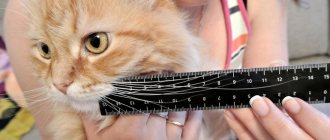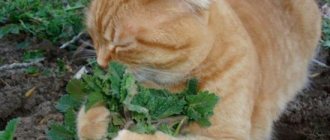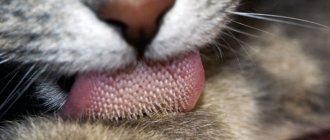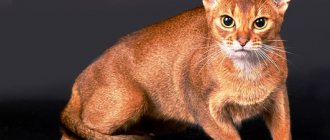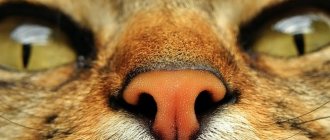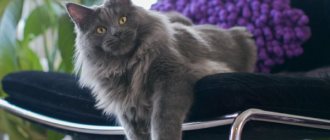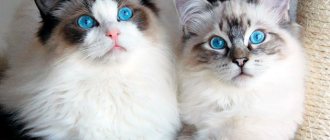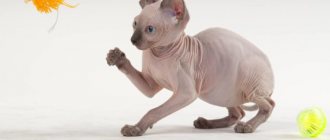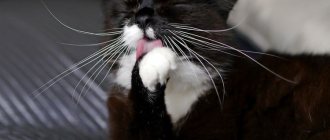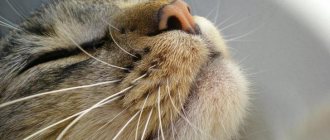General information
A cat's eyebrows are also vibrissae. The average length of a cat's whiskers is 7 cm. But there are exceptions, for example, the Maine Coon breed. In cats of this breed, the whiskers are similar to hair, but several times longer.
The vibrissa is immersed in the hair follicle and surrounded by veins. Each vibrissa has its own area in the brain. Vibrissae, unlike ordinary hairs, have a tactile function and are responsible for sensation. Vibrissae trap air currents.
These are the animal's tactile receptors. Vibrissae from the Latin vibrisse, meaning to vibrate. With their help, cats determine the position of an object, obstacles, and navigate in the dark. Nerve impulses from the whiskers are sent to the brain, which processes the signals sent by this system and creates the surrounding picture.
Vibrissae help the cat to get acquainted and receive information about objects and other animals. The cat approaches an unfamiliar object, pointing its whiskers forward. With their help, the cat determines atmospheric pressure, temperature and humidity. The animal determines all this by slightly moving its whiskers.
Vibrissae help the animal avoid damage to the eyes, assess the speed and direction of the wind, and control the temperature of surfaces. The cat may not see the approaching object, but the whisker will definitely feel the air flow reflected from it.
Interesting! Vibrissae are one of the first hairs that a kitten develops in the womb of a cat mother.
Vibrissae serve as an indicator of the animal's mood. If the whiskers are directed forward, then the animal is showing interest in something and is ready for active action. If the whiskers are pressed to the muzzle, then the cat is aggressive or scared. Vibrissae, like ordinary hair, fall out.
If a cat has lost several whiskers, then there is no need to worry, and on the contrary, you should pay attention if the whiskers leave the cat’s face in large quantities. Excessive fragility is associated with any stress experienced, an unbalanced diet, or dehydration of the animal’s body.
What is the correct name for a mustache and why?
A cat's whiskers give it a sense of space. They are detectors that provide information, for example, about changes in atmospheric pressure, so most folk signs are associated with the behavior of pets.
The scientific name for cat whiskers is vibrissae. The word comes from the Latin - vibro (vibrate, fluctuate). The mustache got its name due to the constant small tremors and vibrations. If you look closely at the cat's face, you will see that the whiskers are constantly quivering. Vibrissae are an organ of touch that allows animals to navigate in complete darkness. Vibrissae are located not only in the area of the upper lip and chin, but also under the eyes and on the paws.
We call the cat's whiskers correctly - vibrissae
Vibrissae are much thicker than normal hair. Each whisker has its own muscle fibers that are responsible for its movement. A nerve impulse departs from each vibrissae to the cerebral cortex, which allows the received information to be processed as accurately as possible. Each cat's whiskers are well supplied with blood and also have access to the trigeminal nerve.
The vibrissae are so sensitive that at the slightest movement of air, they send signals to the brain regarding the position of the body in space.
If your mustache falls out
Loss of whiskers may indicate the presence of the following problems:
1. Skin diseases. In this case, by the loss of whiskers, one can judge whether the animal has diseases such as ringworm or atopic dermatitis. 2. Fungal diseases. In this case, the affected area of the cat's skin becomes itchy and itchy. 3. The presence of parasites in the body. The coat deteriorates due to metabolic disorders, helminthic infestations, and also when infected with fleas or ticks. 4. Endocrine diseases such as hypothyroidism. If they occur, the hair becomes matted and falls out. 5. Folliculitis is inflammation of the follicles. It is caused by bacteria, fungi, and viruses.
Cat's whisker tongue
By the position of the whiskers, you can judge the current mood and condition of the pet. The position of a cat's whiskers clearly indicates the following shades of mood:
- Relaxed state - calmly loosened on the sides of the head.
- Interest, curiosity - the mustache is directed forward.
- Pressed to the sides of the head - anxiety, fear, puzzlement.
- Sank down - bad mood or feeling bad.
A cat's whiskers can tell you about your pet's mood and condition.
The role of whiskers in the life of a cat
If the whiskers are trimmed, the cat will experience discomfort. The animal's perception of the world and orientation deteriorate. The brain does not receive enough necessary information about the world around it. The animal does not orient itself in space, gets stuck in passages, does not orient itself in the room, and often falls.
It is difficult for street animals without vibrissae, as they cannot fully hunt, experience problems with nutrition, and are easily injured. A cat without whiskers loses coordination, may fall from a height, and fail to calculate the jump.
Important: Under no circumstances should you trim your cat’s whiskers. Trimming the whiskers is permissible if the area of the skin on which they are located is infected in any way. The procedure is carried out by a veterinarian who has previously treated the area of skin.
Fortunately for cats, whiskers tend to grow back. This is only if the hair follicle is not damaged. Vibrissae change (fall out and grow again) in 2-3 weeks.
Problems with whiskers in cats and kittens
The condition of a cat's whiskers is an important indicator of health. Therefore, it is necessary to monitor the condition of the vibrissae and take timely measures to eliminate all kinds of troubles that may affect them. The following problems are usually encountered:
- Fragility. It appears due to some deviations in the environment. For example, dry indoor air leads to hair drying out and breaking off. The lack of fresh water in a cat has the same effect on its whiskers. Frequent bathing also has a negative effect on the elasticity of the antennae. The problem is solved by normalizing humidity, having fresh water, and using high-quality hair care products.
Problems with cat whiskers need to be addressed promptly
- Dropping out. Losing a mustache is a more serious signal than breaking it off. A serious signal of health problems. Loss of whiskers often accompanies allergic reactions in cats. Allergies in a pet usually occur to food, most often to milk and fish. When faced with whisker loss, you should pay attention to your cat's diet. Vitamin deficiency also causes massive loss of mustaches. It occurs against the background of a monotonous diet, which causes a deficiency of important microelements and vitamins.
- Poor growth. Poor whisker growth depends primarily on the general condition of the cat. The quality of food, the presence of vitamins and microelements, good coat care - all this is directly related to the growth of not only the whiskers, but also the animal itself. Poor mustache growth can also be caused by endocrine problems and metabolic disorders. If improving the quality of keeping your cat does not lead to a positive result, you need to contact a specialist.
Causes of mustache loss
If you notice a cat's whiskers falling out, there is no need to panic. This is normal: old mustaches die off and new ones grow in their place. But if the pet suddenly began to lose whiskers, and new ones never appeared, this indicates a serious malfunction in the body.
Lack of vitamins in the body
Vibrissae begin to fall out when the cat’s diet lacks vitamins A, D, collagen and taurine, and certain microelements. With a lack of these beneficial substances, the disease can be accompanied not only by loss of whiskers, but also by hair, bad breath, and poor condition of the claws.
In this case, you need to contact a veterinarian and undergo the necessary tests to determine which vitamin is missing. Then it will be enough to change the diet and add foods rich in the vitamins the cat needs.
Lightened and falling out whiskers may indicate the presence of worms in the animal.
Thyroid problems
Disturbances in the functioning of the thyroid gland, deficiency or excess of its hormones also lead to loss of mustache. These problems are most common in older cats.
Additional symptoms are diarrhea and vomiting, constipation. If these signs are present, you should immediately contact a specialist who will prescribe a course of treatment. Self-medication will only worsen your pet's condition.
Skin diseases
Bacterial and infectious diseases can cause itching and irritation in your cat. The reason for this may be injuries, scratches, cuts.
Severe itching, weakness and loss of appetite appear.
Allergy
Due to food allergies, cats may experience hair and whisker loss. To stop this, you need to find out what product is causing your pet’s allergy and eliminate it from the diet.
If your cat has problems with its whiskers, pay attention to:
- Air humidity in a house or apartment;
- Availability of a bowl of water. Mustaches can fall out due to dehydration;
- Quality of animal feed. It must contain natural ingredients, be balanced and not have harmful additives;
- Bathing mode. It is enough to wash the cat once every 3 months;
- Hairless breeds require frequent bathing - once every two weeks in the spring and every month in the winter. The cause of mustache loss can also be the wrong shampoo;
- Time of year and puberty.
If you do not fight the loss of whiskers, this will lead to the pet becoming confused, fearful, and unable to navigate the area, even if it is an apartment in which he has lived his whole life. And on the street such a cat has a negligible chance of survival.
Why can't you trim them?
During shedding, cats may naturally shed a few hairs from their whiskers, which will grow back over time. Sometimes you may feel that your cat's whiskers are too long and want to trim them. The main question that comes to mind before trying to implement your plan is whether it will harm the cat?
The answer is clear: you cannot trim your mustache unless absolutely necessary! If your cat does need to trim his whiskers, they should grow out within a few months. During this time, give your cat the space it needs to navigate its environment, as animals may become nervous due to a lack of spatial awareness. Whiskers are important to your cat's safety and are the foundation of her self-confidence.
Now that we've talked a little about mustaches, I want to know what you think about it? Maybe you know some other facts about these cat attributes? Let us know in the comments!
Orientation in space
The distance between the whiskers approximately corresponds to the width of the cat's body. Murchik uses them to test whether he can fit, for example, in a tunnel or hole under a fence. Moreover, “eyebrows” are also used for this. If the lint touches the edges of the hole, he will likely give up, knowing that it is too narrow for him.
With the help of their whiskers, cats detect even the slightest changes in the air. Thanks to this, they can easily move in the dark because they sense changes in the air flow around objects. This sounds like science fiction, but it is a fact - cats never bump into objects even in the complete absence of lighting.
The ability to detect changes in the surrounding air space allows cats to avoid enemies.
This property is also very helpful in hunting, since the cat can easily determine in which direction the potential prey is moving. Check it out while playing with your purr. You will be convinced that the cat “sees” the swinging toy even with his back to it.
